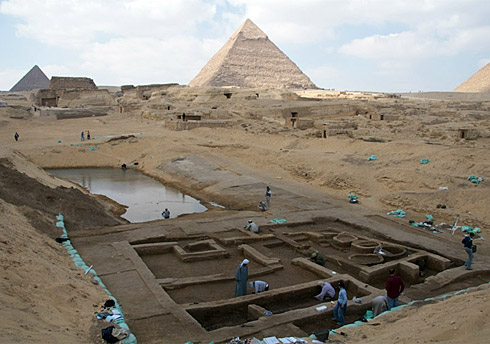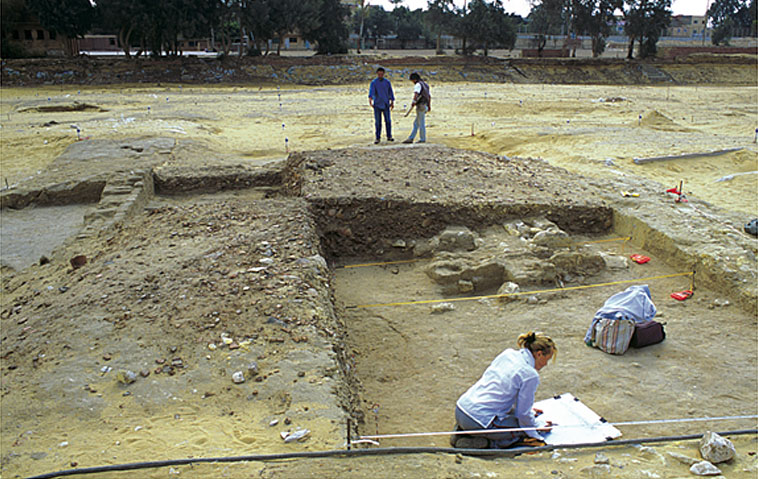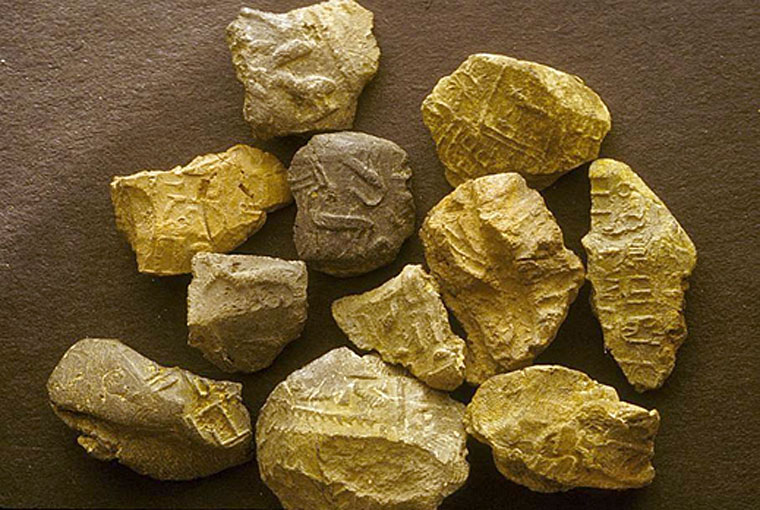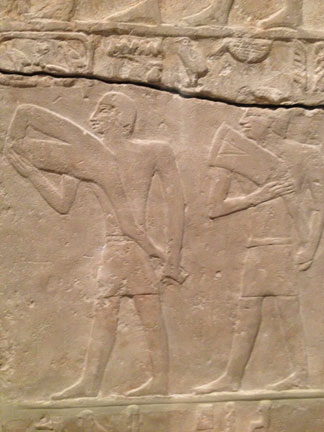By Richard Redding
I am looking forward to arriving in Egypt on April 10th. Our research design this season has unified our excavation and material culture studies strategies. I will be looking at the animal bone from the Silo Building Complex (SBC) testing the idea that the area was occupied by priests associated with offerings for one or more of the Pharaohs whose tombs lie at Giza. How can animal bones tell us about the “job” of the residents of an area? How can I test this idea?

The SBC complex in 2012. View to the west, photo by Mark Lehner.
The story starts several years ago when work on the Western Town district in our flagship Lost City of the Pyramids site (Heit el-Ghurab) uncovered a garbage dump we called the Pottery Mound. The Pottery Mound is a garbage dump located between two buildings in Western Town, one of which, House 1, has been entirely excavated. The Pottery Mound deposit was filled with pottery, animal bones and sealing fragments.

Excavation of the Pottery Mound. View to the east, photo by Mark Lehner.
The sealing fragments from the Pottery Mound contained titles of very high status individuals, all scribes, like: “scribe of the royal documents”, “scribe of the royal document box”, and “scribe of royal works”. So, the garbage came from a group of scribes, probably working in a scribal workshop in the adjacent House 1, the largest residence in the Lost City site (as far as we know). These scribes were undoubtedly very high status individuals.

Sealing fragments from area AA, adjacent to the Pottery Mound. Photo by Mark Lehner.
What did the animal bone from the Pottery Mound tell me?
So much animal bone was recovered I did not have time to do it all, but I did identify over 100,000 fragments of bone. The majority of the animal bone was from cattle. I identified 14.1 cattle bone fragments for each sheep-goat fragment. Since each cow/bull/steer provides about 8-9 times as much meat as a sheep-goat, 99% of the meat consumed was from cattle. The contributions of all other animals were insignificant. The cattle were very young males, 10-12 months of age. The residents whose garbage ended up in the Pottery Mound were eating the highest status diet I have found at the Heit el-Ghurab; that is, they dined on meats that ancient Egyptians considered the most desirable and the most costly. Elsewhere in the town, sheep, goat, and catfish provided much of the meat in the diet.
I also identified in the Pottery Mound sample two teeth from a leopard. Sem priests, who performed mortuary offering rituals, wore leopard skins with the head attached. They were high ranking individuals, often the tomb owner’s son. So, again we have evidence that the garbage in the Pottery Mound is associated with high status individuals.

A leopard tooth from the Pottery Mound A Sem priest wearing a leopard skin
But this is not the entire story. I examined the body part distribution among the cattle and found a strong bias toward hind limb fragments. If whole cattle were being butchered and consumed in the area, I would expect a ratio of 1.1 hind limb bone fragments for each fore limb fragment. What I found in the sample was 36.1 hind limb fragments for each fore limb fragment. Where did all the forelimb fragments go?
In visits to tombs and temples throughout Egypt, I have noticed that the cattle being slaughtered for offerings are always illustrated with the forelimb being cut off, and the offerings illustrated are always forelimbs. I have found only one example of a hind limb being removed, and that was in the offering chapel of Sekhemankhptah from the Old Kingdom at Saqqara.

Forelimbs being removed from offering cattle

Forelimbs of cattle being carried in as offerings to the tomb owner
During our 2013 study season, I identified the animal bone from House 1, the structure next to the Pottery Mound, and found an identical dependence on young, male cattle, bias toward hind limbs and more leopard teeth.
So, what we appear to have in the Pottery Mound and House 1 are the “leftovers” from the slaughter of cattle for offerings. After this analysis I predicted that if we ever found an area occupied by offering priests, it should have a bias toward forelimbs.
In 2012, I identified the small sample of animal bones recovered from the SBC. The cattle were very young. I identified 4 hind limb fragments and 31 forelimb fragments in the sample: a clear bias toward fore limbs. Could this be the garbage from offering priests?
This season I am very excited to get back and look at the sample of bone recovered. The 2014 team is excavating areas that we will yield the highest number of the animal bones. I want to see if the bias toward forelimbs holds in the larger sample. I also expect to find more sheep-goats and pigs in garbage dumped by offering priests, as they needed to supplement their diet.
By mid-April I will know a great deal more and I will let you know what I find.
